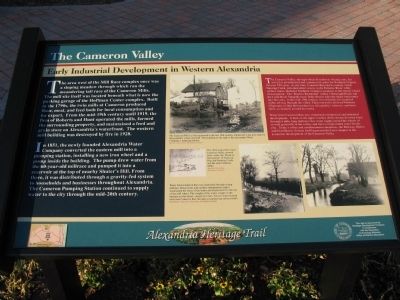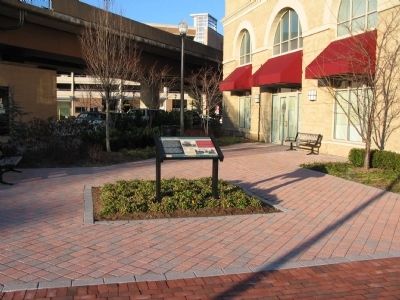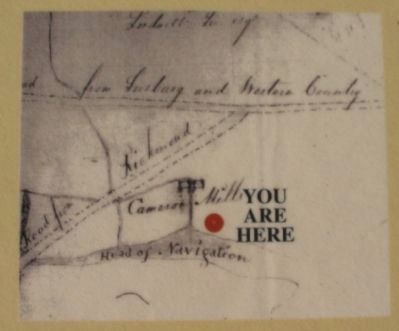Eisenhower East in Alexandria, Virginia — The American South (Mid-Atlantic)
The Cameron Valley
Early Industrial Development in Western Alexandria
— Alexandria Heritage Trail —
The area west of the Mill Race complex once was a sloping meadow through which ran the meandering tail race of the Cameron Mills. The mill site itself was located beneath what is now the parking garage of the Hoffman Center complex. Built in the 1790s, the twin mills at Cameron produced flour, meal, and feed both for local consumption and for export. From the mid-19th century until 1919, the firm of Roberts and Hunt operated the mills, farmed the surrounding property, and maintained a feed and grain store on Alexandria's waterfront. The western mill building was destroyed by fire in 1928.
In 1851, the newly founded Alexandria Water Company converted the eastern mill into a pumping station, installing a new iron wheel and a pump inside the building. The pump drew water from the 60-year-old millrace and pumped it into a reservoir at the top of nearby Shuter's Hill. From there, it was distributed through a gravity-fed system to households and businesses throughout Alexandria. The Cameron Pumping Station continued to supply water to the city through the mid-20th century.
[Sidebar:]
The Cameron Valley, through which Eisenhower Avenue runs, has served as an industrial and commercial center for Northern Virginia for over 250 years. At one time, Cameron Run and its estuary, Great Hunting Creek, provided direct access to the Potomac River, while surface routes funneled Northern Virginia's products to the stream's head of navigation. The "Road to Richmond" (today's Telegraph Road) and the Little River Turnpike (now Duke Street) were the major land routes into this area. In the mid-19th century, two railroads also acquired rights-of-way through the valley. These networks allowed Northern Virginians to ship their products to Alexandria's wharves, and from there, to markets around the world.
Water from Cameron Run also stimulated commercial and industrial development. A dam on the upper reaches of the stream diverted water through a mile-long millrace; this water supply turned the wheels of several gristmills in the valley, and later even provided water for the city. Today's office and condominium complexes, the Beltway, Metro, and Eisenhower Avenue itself represent the latest chapter in the economic development of the Cameron Valley.
Erected by the City of Alexandria.
Topics and series. This historical marker is listed in these topic lists: Industry & Commerce • Railroads & Streetcars • Roads & Vehicles. In addition, it is included in the Virginia, The City of Alexandria series list. A significant historical year for this entry is 1919.
Location. 38° 48.07′ N, 77° 4.191′ W. Marker is in Alexandria, Virginia. It is in Eisenhower East. Marker is on Eisenhower Avenue, on the right when traveling west. The marker is located across the street from the Eisenhower Street Washington Metro station. It stands in the Eisenhower East neighborhood of Alexandria. Touch for map. Marker is in this post office area: Alexandria VA 22314, United States of America. Touch for directions.
Other nearby markers. At least 8 other markers are within walking distance of this marker. Hubert N. ("Dutch") Hoffman, Jr. (about 700 feet away, measured in a direct line); The Bloxham Family Cemetery (approx. 0.4 miles away); The Bloxham Cemetery: Portal to the Past (approx. 0.4 miles away); Fort Ellsworth (approx. 0.4 miles away); George Washington Masonic National Memorial (approx. half a mile away); Panoramic View of Alexandria (approx. half a mile away); a different marker also named The George Washington Masonic National Memorial (approx. half a mile away); Fighting Back (approx. half a mile away). Touch for a list and map of all markers in Alexandria.
More about this marker. In the upper center is a photo of The Cameron Mills as they appeared in the late 19th century. On the left is the grist mill, by then partially steam-powered. The building on the right is the Alexandria Water Company's pumping station.
In the lower center is a section of map. The 1803 map of the lower Cameron Valley showed early roads, the "Head of Navigation" of Cameron Run and Hunting Creek, and the twin Cameron Mills.
In the lower center and right are photos of Cameron Run. Water from Cameron Run was channeled through a long millrace whose stone and earthen embankments maintained the force of the water and channeled it to the top of the mill wheel. The weight of the water, caught in the buckets on the wheel, caused it to turn. Excess water flowed back into Cameron Run through a meandering tailrace.
Credits. This page was last revised on January 20, 2024. It was originally submitted on February 6, 2010, by Craig Swain of Leesburg, Virginia. This page has been viewed 2,416 times since then and 157 times this year. Photos: 1, 2, 3. submitted on February 6, 2010, by Craig Swain of Leesburg, Virginia.


